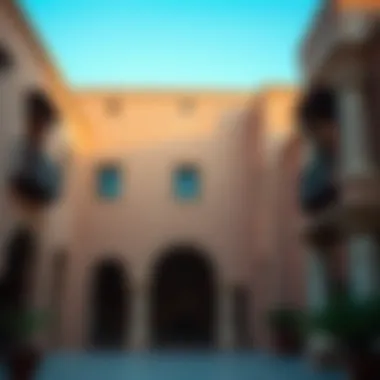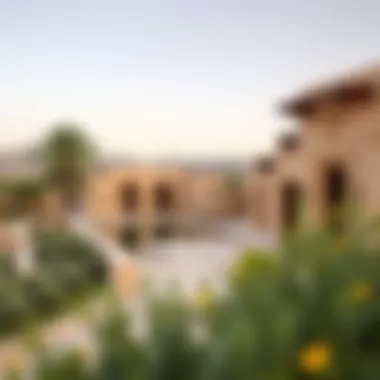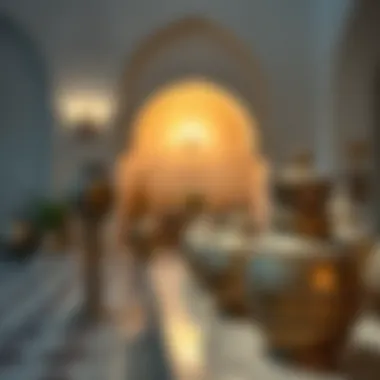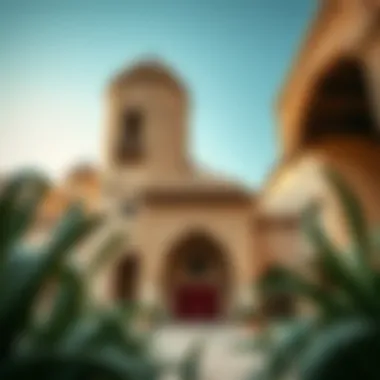Discovering Jazira Al Hamra's Rich Heritage


Intro
Jazira Al Hamra, a remarkable heritage village tucked away in the United Arab Emirates, offers a fascinating glimpse into the lives and traditions of the past. Historically, it served as a prominent fishing and trading settlement, with architecture that speaks volumes about Arabian culture and craftsmanship. The village, often referred to as the "Red Island," earned its name from the distinct reddish-brown coral stone used in its construction. This article dives into the intricate tapestry of Jazira Al Hamra. It not only illuminates the village's historical significance but also highlights its cultural practices, architectural styles, and that vital bridge between history and modernity.
Importantly, this exploration extends beyond mere observation. It digs deeper into the intersection of cultural heritage with today's bustling real estate market in Dubai. Real estate professionals will find fresh insights about how heritage can shape investments and influence market trends, all while navigating the delicate balance of preserving historical sites amid soaring modern developments. By examining Jazira Al Hamra, we uncover more than just bricks and mortar; we reveal an enduring connection to the past that continues to resonate today.
The forthcoming sections will unravel the various dimensions of Jazira Al Hamra, bringing to light its architectural wonders, cultural practices, and relevance in the current property landscape. In capturing these elements, we aim to engage not only historians and enthusiasts but also investors and professionals keen to integrate cultural significance into their ventures.
Thus, buckle up as we embark on this enriching journey through a village that brilliantly encapsulates the essence of the UAE's rich history.
Prelude to Jazira Al Hamra
Jazira Al Hamra, a historical gem nestled in the heart of the United Arab Emirates, stands as a testament to the region's rich cultural lineage and architectural prowess. Its importance stretches beyond mere historical interest; it offers insights into the sociocultural dynamics that shaped the lives of its past inhabitants. This narrative weaves the tale of a once-thriving coastal village, serving as a hub for fishing and trade. For buyers and investors, understanding Jazira Al Hamra is imperative, as it blends heritage with modern aspirations in property development.
Geographic Location and Overview
Situated just south of Ras Al Khaimah, Jazira Al Hamra lies nestled along the coast of the Arabian Gulf. This strategic location has played a vital role throughout its history, enabling access to key maritime routes. Previously, the village's proximity to water influenced its economic activities, primarily fishing and pearling, which were the lifelines of the community. Today, the area presents a juxtaposition of historical architecture and contemporary growth, making it a site worthy of exploration for both real estate enthusiasts and cultural aficionados.
The landscape of Jazira Al Hamra is marked by the remnants of traditional mud-brick structures, with enchanting narrow alleyways and wind-tower features that catch the sea breeze. Visitors often find themselves enchanted by the rustic allure of the village. As one meanders through the ruins, the ghost of bygone days echoes in the silence, with every corner narrating a story of resilience and cultural richness.
Historical Context
To fully appreciate Jazira Al Hamra today, one must look back at its inception. Established in the early 20th century, the village thrived until the mid-20th century when rapid economic transformations led the community into a decline. Key industries, such as agriculture and fishing, were pivotal during its heyday. However, the advent of modernity and increasing urbanization forced many residents to relocate, leaving behind a foundational piece of the UAE’s heritage.
The village's abandonment opened up discussions around preservation and heritage tourism, as more people started recognizing its historical significance. While statistics regarding the number of archived records remain scarce, archaeological findings continually paint a picture of an active and rich community life. Notably, the area's fishing history emphasizes the maritime culture of the time.
In recent years, efforts to rejuvenate Jazira Al Hamra have picked up steam, driven by local government initiatives and community support. The village is not merely a ghost town but a lively exhibit illuminating the UAE's evolution. Its stories and vestiges speak volumes about the lives of those who once thrived here.
A quote from an expert in cultural heritage preservation stated, "Places like Jazira Al Hamra remind us that what once was, continues to shape who we are today."
In analyzing Jazira Al Hamra, one sees a microcosm of the broader narrative of the UAE — a land where tradition and modernity often collide, creating a unique tapestry of cultural identity. Thus, Jazira Al Hamra deserves not just a brief glance but an earnest evaluation, particularly for those deeply invested in understanding the intertwining of heritage and contemporary aspirations.
Architectural Features of Jazira Al Hamra
The architectural dimension of Jazira Al Hamra is not just a series of buildings; it is a mosaic that tells the story of a bygone era. The significance of Jazira Al Hamra’s architectural features lies in their ability to showcase the rich cultural identity of the UAE, blending functionality with aesthetic appeal. This section examines the critical components that define these architectural features, from traditional building materials to unique styles, and it highlights the importance of their preservation.
Traditional Building Materials
The materials used in constructing the structures of Jazira Al Hamra tell much about the ingenuity of its inhabitants. Builders relied heavily on locally sourced materials, which reflected the practical needs of the community as well as the climatic conditions of the region. Common materials included:


- Coral Stone: This was often harvested from the surrounding sea, providing robust foundations and walls that could withstand the harsh coastal winds.
- Mud and Clay: These materials were used for plastering and wall construction, which was beneficial in terms of insulation against heat.
- Date Palm Fronds: These served both structural and decorative purposes, demonstrating the adaptive use of local resources.
Utilizing such materials did more than just serve the architectural needs; it fostered a deep connection with the environment. The choices made in construction underscore the harmony between the built environment and nature, reflecting an understanding of sustainability long before it became a modern concern.
Distinctive Architectural Styles
When we walk through Jazira Al Hamra, we observe various architectural styles that narrate the region’s past. One prominent style is the Islamic architecture, characterized by intricate geometric patterns and calligraphic inscriptions. However, what sets Jazira Al Hamra apart is its unique Barjeel design—the wind towers that rise above the buildings, proving to be an excellent example of passive cooling.
Other notable aspects include:
- Courtyard Layouts: Homes were designed around central courtyards, offering private spaces for family life while encouraging air circulation.
- Mashrabiya: These wooden latticework screens not only added to the aesthetic appeal but also provided privacy and allowed for cooling breezes to enter homes.
The architectural styles are a blend of practicality and aesthetic allure, revealing insights about social structure, socio-economic status, and the cultural fabric that once flourished within Jazira Al Hamra.
Preservation of Architectural Heritage
The ongoing effort to preserve Jazira Al Hamra's architectural heritage is crucial in today’s rapidly developing landscape. Recognizing the importance of these structures as part of the United Arab Emirates' national identity, various initiatives have been launched.
"Jazira Al Hamra represents a link to the past that shapes our present and future. It's a treasure we must protect—both for its historical significance and for future generations."
However, the path to preservation is fraught with challenges, particularly due to the pressure of urban development. Some initiatives include:
- Restoration Projects: Engaging specialists to restore buildings using traditional techniques and materials.
- Awareness Campaigns: Educating the public on the historical value of the village to rally community support for preservation efforts.
- Regulations: Enforcing building codes that safeguard the integrity of the historic sites while allowing for modern enhancements.
With the right balance between development and conservation, Jazira Al Hamra can remain a vibrant reminder of the UAE's rich history and cultural significance.
Cultural Significance of Jazira Al Hamra
Jazira Al Hamra stands as a testimony of the cultural fabric of the United Arab Emirates. Beyond its historical architecture, the village offers invaluable insights into how communities once coexisted and thrived in a harsh desert environment. Understanding the cultural significance of Jazira Al Hamra means recognizing its role not just as a physical place, but as a keeper of stories, traditions, and social practices that have shaped the local identity over generations.
Community Lifestyle in Historical Context
The lifestyle in Jazira Al Hamra was intricately connected with its surrounding environment. The villagers relied heavily on the sea, engaging in fishing and pearl-diving, which were the lifeblood of their economy. Unlike the fast-paced urban lifestyle seen today, life was slower, rooted in communal gatherings and shared chores. Each family was part of a larger network, often engaging in trade and cooperation to ensure survival. Homes were designed not just for shelter, but as spaces for social interaction. The open courtyards, where families and neighbors would congregate, fostered a strong sense of community.
This interconnectedness is reflected in the artifact finds; fishing nets, traditional boats, and household tools reveal much about daily activities. These remnants of daily life provide clues to understanding how the residents adapted to their surroundings, not merely surviving, but also creating a rich, vibrant culture.
Customs and Traditions
Customs in Jazira Al Hamra were deeply rooted in Islamic teachings and local practices, marking the village's identity. Religious observances dictated much of the calendar, punctuated by festivals which brought people together. Marriage ceremonies, for example, were grand affairs lasting several days, filled with music, food, and elaborate rituals that expressed community joy and continuity.


Another important aspect of life was oral storytelling, a tradition passed down through generations. Elders would share tales of bravery, wisdom, and adventure, keeping the culture alive and entertaining youngsters. Such practices fostered shared values and a collective memory that bonded residents. The art of Arabic dance and music also played a vital role in social gatherings, creating a rich tapestry of cultural expression.
Annual Festivals and Events
The annual festivals in Jazira Al Hamra symbolize the vibrancy of local culture. The date of the Eid celebrations is a highlight of the year, where the spirit of giving is amplified. Villagers come together to share food and gifts, embodying the essence of community.
- The Pearl Diving Festival pays homage to the area’s economic roots, celebrating the centuries-old tradition of diving. People gather to reminisce about the hardships and honor those who once braved the sea for a better life.
- The Traditional Market Day brings craftsmen and women together, showcasing local artisans. From intricate textiles to handmade pottery, these events enable the passing down of skills while supporting local economy.
"Engaging with the annual festivals allows us to appreciate not just the celebratory spirit, but also the resilience of the people. It’s a glimpse into a way of life that continues to inspire!"
In essence, the cultural significance of Jazira Al Hamra is multifaceted. It is an amalgamation of daily lives, traditions, and celebrations that weave together a historical narrative, important not only for locals but also valuable for anyone interested in the wider cultural landscape of the UAE. Understanding these rich layers of life in Jazira Al Hamra shines a light on the importance of preserving such heritage sites, ensuring their stories endure for generations to come.
For a deeper dive into the cultural heritage of the UAE, explore useful resources such as Wikipedia - Jazira Al Hamra or Britannica.
Visiting sites like Reddit can offer discussions and valuable insights into community experiences related to Jazira Al Hamra.
Modern-Day Relevance
The present-day significance of Jazira Al Hamra cannot be understated. This heritage village stands not merely as a relic of the past, but as a vibrant testament to how historical narratives can converge with modern realities. In an age characterized by rapid urban expansion and development, the lessons drawn from Jazira Al Hamra hold immense value for a diverse audience, ranging from property investors to urban planners. Understanding these dimensions allows for constructive conversations on preserving cultural integrity while fostering economic growth.
Impact of Urban Development on Heritage Sites
Urban development, while crucial for economic progress, has a tendency to overshadow historical sites, pushing them to the periphery. Jazira Al Hamra is no exception; its existence is influenced by the large-scale urbanization of the surrounding areas. The juxtaposition of contemporary buildings against the backdrop of traditional architecture poses challenges but also opportunities.
One main impact of urban development is the threat of physical erosion that heritage sites face. As new businesses spring up or residential neighborhoods expand, the original essence of places like Jazira Al Hamra can easily be lost. However, there are several positive outcomes of urbanization that can contribute to the village's longevity:
- Increased Awareness: As modern developments rise around heritage sites, more people become aware of the need to cherish and protect these areas for future generations.
- Tourism Boost: Increased urban traffic often leads to higher footfall in nearby heritage sites, including Jazira Al Hamra, encouraging local economies to invest in preservation initiatives.
- Community Engagement: The convergence of modern lifestyles with historical narratives often sparks local initiatives aimed at preserving culture, bringing together disparate groups with a common purpose.
Economic Considerations for Property Investors
The implications for investors in property transactions in Jazira Al Hamra are manifold. Engaging with a heritage site can provide a unique avenue for investment that transcends conventional property deals. A few considerations for potential investors include:
- High Demand for Authenticity: Properties integrated with cultural heritage often enjoy increased valuation, owing to their unique charm and historical significance. Investors can capitalize on this demand by developing while respecting the village’s essence.
- Government Incentives: Local government initiatives may provide financial incentives for restoring heritage buildings, which can make initial investments less daunting.
- Market Trends: The persistent rise in interest for cultural heritage can lead to stable or appreciating property values; therefore, cultivating a personal connection to the local culture may yield dividends.
Integration of Culture in Modern Real Estate
In today’s real estate climate, blending the modern with the traditional is not just commendable; it is vital for enduring relevance. The culture embedded in Jazira Al Hamra presents real estate developers with a fertile landscape for fostering authentic experiences. Key strategies for integrating culture into modern projects could involve:
- Cultural Fusion Designs: Consider architectural styles that harmoniously merge traditional elements with contemporary designs, enhancing aesthetic appeal without compromising cultural authenticity.
- Community-Centric Developments: Real estate ventures that prioritize community engagement often see better success because they align with the values of the local inhabitants.
- Promotional Practices Rooted in Tradition: Marketing properties as part of a cultural narrative can attract discerning buyers who seek more than just a modern living space.


Jazira Al Hamra exemplifies how ancient histories can blend seamlessly into contemporary life. Understanding the modern-day relevance of such a village is crucial not just for real estate professionals but for anyone keen on maintaining a connection with their past while stepping boldly into the future.
Challenges in Preservation
Preserving the historical essence of Jazira Al Hamra is akin to capturing lightning in a bottle. As the tides of modernization wash over traditional landscapes, the challenges of keeping cultural heritage sites intact are numerous and not to be taken lightly. This section delves into the pressing issues that intertwine development and conservation, highlighting how these factors influence the sustainability of Jazira Al Hamra.
Balancing Development and Conservation
The UAE is no stranger to rapid urban transformation, and Jazira Al Hamra is at the crossroads of this expansion. Developers eye the land for its potential profits, while historians and local advocates yearn for its preservation. Striking a balance between these two conflicting aims necessitates thoughtful planning and dialogue among stakeholders.
One of the foremost challenges is the pressure from real estate developers. The lure of high returns on investment leads to aggressive initiatives aimed at converting heritage areas into commercial and residential properties. Yet, the significance of Jazira Al Hamra lies not just in physical structures but in the stories they tell about the past. To complicate matters, government regulations often inadequately address the nuances of cultural significance, leading to an erosion of local heritage amidst the clamor of new development.
This dilemma has unfurled its own complexities, including:
- Community Displacement: As new projects emerge, existing communities may find themselves in a precarious position, often feeling sidelined by those seeking profit.
- Loss of Traditional Knowledge: With the vanishing of old structures comes the risk of losing the craftsmanship and skills unique to local artisans.
- Architectural Integrity: New developments can overshadow or even dismantle the precise architectural details that tell the story of Jazira Al Hamra's rich history.
Finding a middle ground is essential. By integrating modern amenities into heritage sites, developers could ensure community needs are met while safeguarding cultural authenticity. Promoting awareness, educating the public, and fostering respect for historical narratives may pave the way for a more harmonious coexistence. Sharing these values across the board can help to foster a culture of preservation rather than mere exploitation.
Government Initiatives and Policies
Government involvement remains critical in steering the conversation toward equilibrium between growth and conservation. Various initiatives have been launched to bolster preservation efforts while accommodating the demands of modernization.
For instance, laws could be put forth to protect historical sites and mandate that developments respect the original architecture. Such policies might include:
- Heritage Impact Assessments: Before construction projects are greenlit, a thorough assessment can be conducted to understand the potential implications on Jazira Al Hamra's cultural significance.
- Funding for Restoration: Allocating funds towards the restoration of historical structures rather than their demolition prepares a landscape where cultural heritage can flourish alongside modern developments.
- Community Involvement in Decision-Making: Engaging local communities when planning developments ensures that their voices and histories are acknowledged and heard.
"To preserve is to remember; to forget is to lose both our past and our future."
For further reading on best practices and policy recommendations, refer to resources such as UNESCO and reports by local government agencies focused on urban development in cultural heritage sites.
Finale
As we draw the curtain on our exploration of Jazira Al Hamra, it's important to pause and reflect on why this heritage village holds such significance both historically and in contemporary contexts. It’s more than just a relic of the past; it embodies the social and economic fabric that shaped the region.
The Future of Jazira Al Hamra
Looking ahead, Jazira Al Hamra is at a crossroads. The challenge is to enliven its historical essence while accommodating the needs of modernity.
- Sustainable Tourism: The potential for responsible tourism is immense. Visitors can gain insight into local customs while also driving revenue for community development. By promoting cultural experiences without commercializing tradition to an extreme, Jazira could become a model for heritage tourism.
- Educational Initiatives: Schools and community groups can use this site as an educational tool, allowing younger generations to learn about their heritage. Developing programs that focus on its significance in the UAE's history could cement Jazira's role as an educational hub.
- Civic Engagement: Fostering conversations around preservation efforts can bring communities together. Residents and stakeholders must actively participate in dialogues concerning its conservation. Town hall meetings might engage locals in discussions that matter to them, forming a collective responsibility towards safeguarding their heritage.
Significance for Real Estate Professionals
For real estate professionals, Jazira Al Hamra isn't just a slice of history; it represents an opportunity to integrate cultural value with property investment.
- Market Insights: In today's market, properties that carry historical or cultural significance often draw a project interest from buyers seeking more than just bricks and mortar. The story behind Jazira can enhance property values, making them attractive for investors who understand the appeal of blending heritage with modern living.
- Heritage Property Development: There exists a niche market for developing properties that harmonize past traditions with contemporary needs. Architects and developers could leverage this unique storytelling aspect as a selling point to discerning buyers seeking authenticity.
- Cultural Responsiveness: A greater awareness of local culture can set real estate professionals apart from competitors. Properties that are designed with regard for the surrounding heritage may resonate more with buyers. Additionally, investors who advocate for thoughtful, culture-rich developments are likely to gain favor from local authorities and the community, alike.
"The fusion of history and modernity isn't just an option; it’s a necessity for thriving communities."











